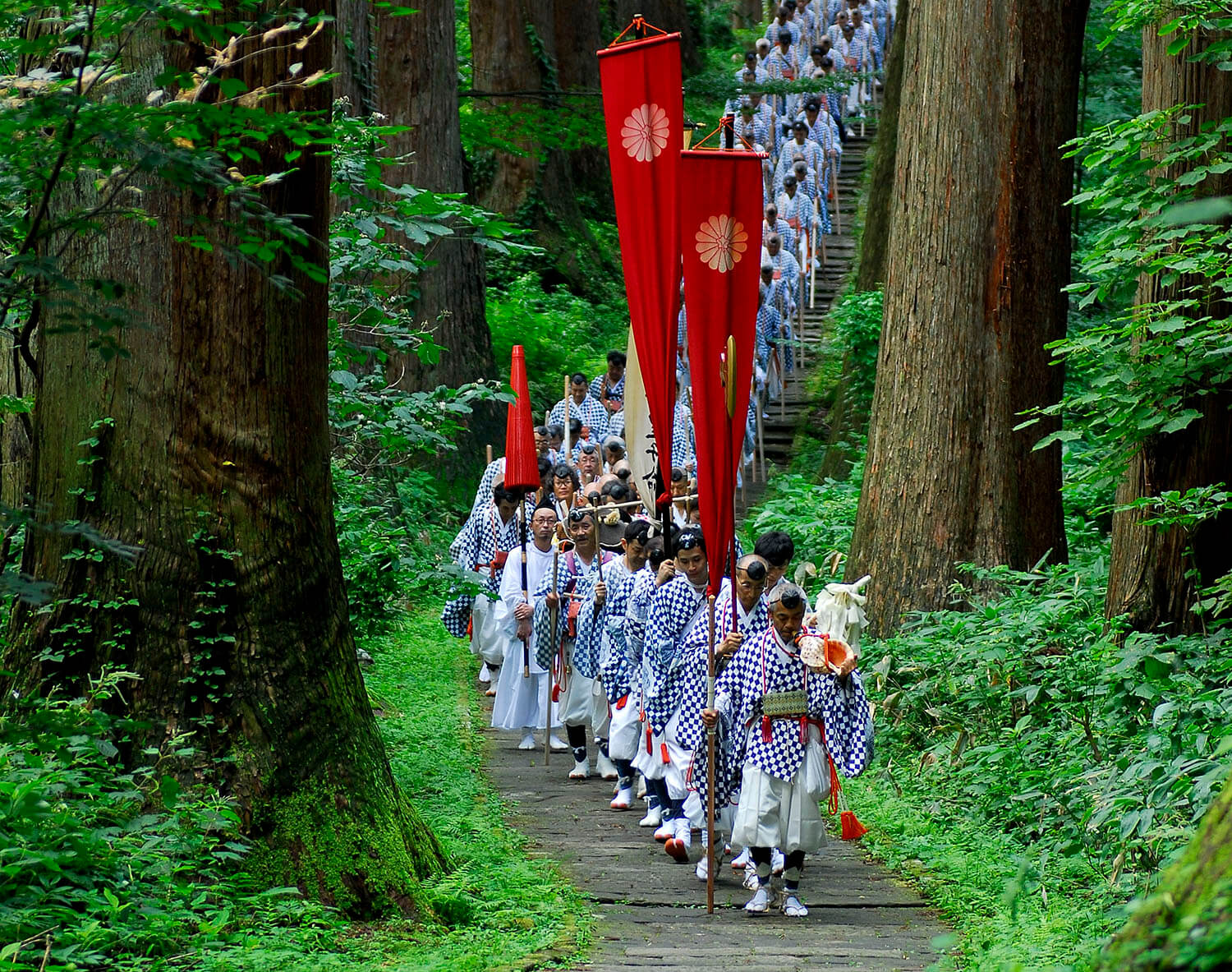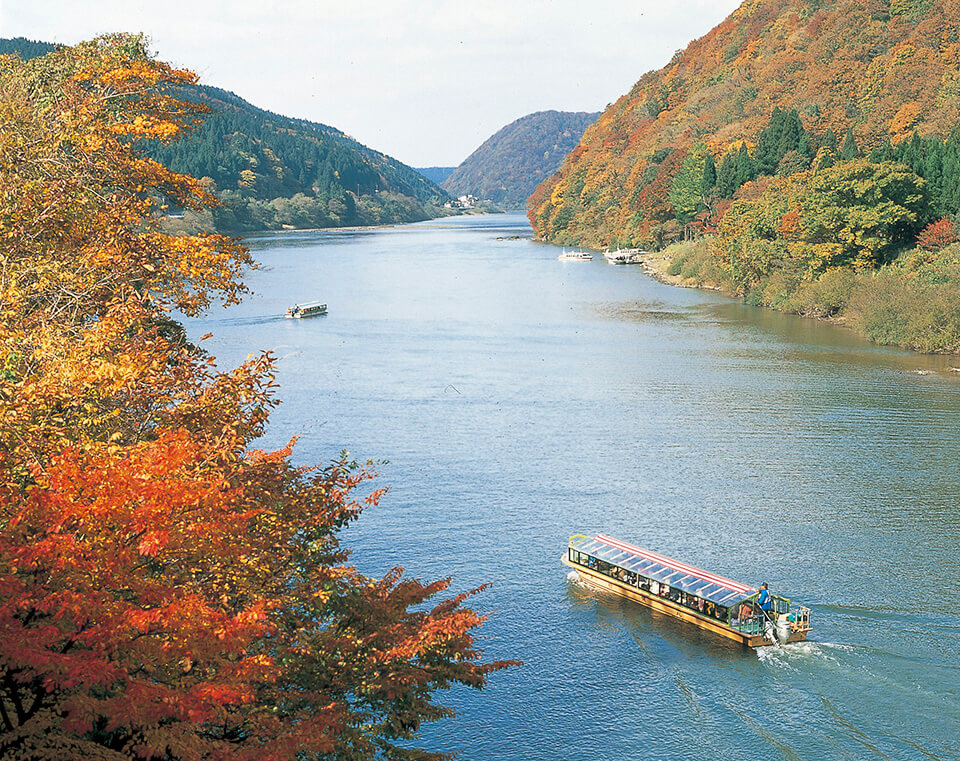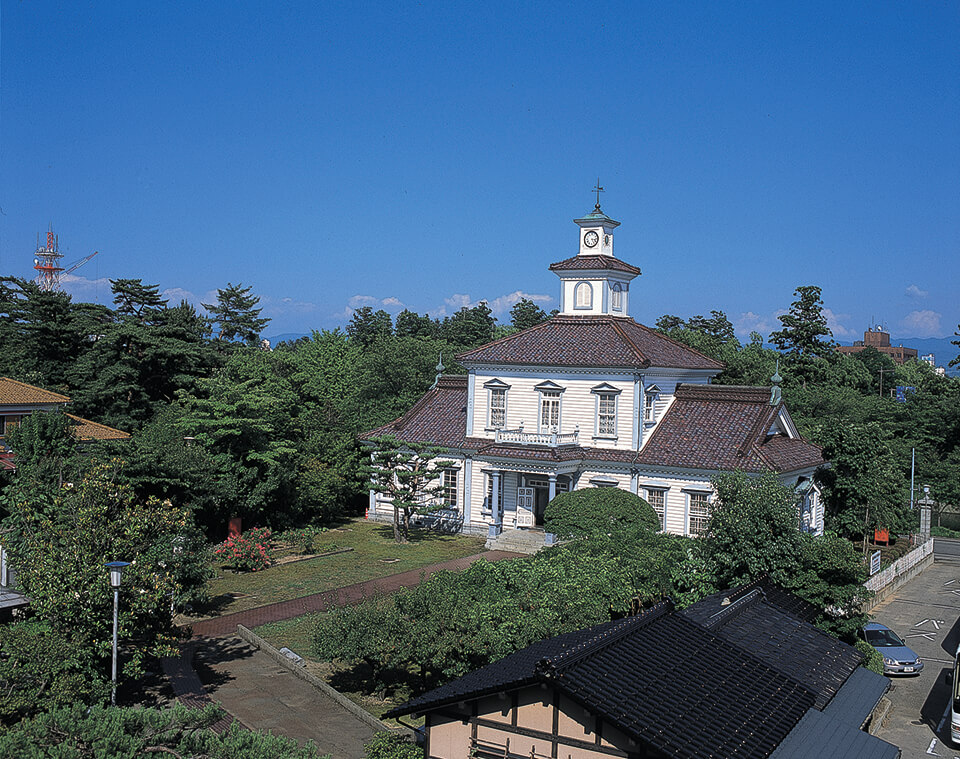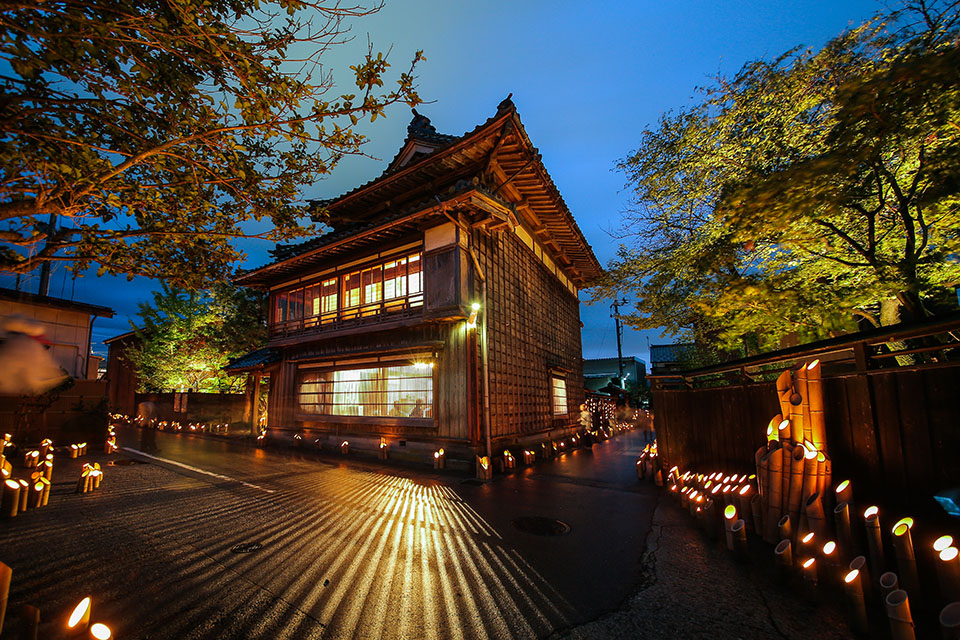In the Uetsu area, you can experience historical Hansei period castle towns of Tsuruoka and Murakami, to the port city of Sakata, which grew from the cargo ships that sailed the Sea of Japan in the Edo period, and even the Mogami River, where you can take a long-historied boat ride that feels like a time machine to the past. While the area has many natural areas and scenery, it also has a rich history and culture that draws in and fascinates visitors from all over.
Kitamaebune Culture
~The land whose culture thrived on trade and commerce~
In 1672, due to the rising population in Edo at the time and the increasing demand of rice, the shogunate appointed merchant Zuiken Kawamura to start the “Nishimawarikouro” (west circuit sea route )which ran from the Sea of Japan to the Seto Inland Sea. The Sakata harbor quickly developed and became a keypoint in the route which sent ships to Osaka and Edo. Due to this, the port quickly grew as a merchant town, and culture from areas like Kyoto came flooding in.
Besides rice, other goods traded to the Kyoto area from the Mogami River boats included safflower and ramie (a perennial plant in the nettle family used in high class weaving, samurai costumes, and wealthy class kimonos).

トップに入れては.jpg)
Through the coastlines and the Nishimawarikouro route, the Mogami River became the heart of the spread of culture through the prefectures specialty products, as well as other trade goods. The marine culture in this area also gave birth to many wealthy farmers and merchants. Through this flourishment, the area became a place of diverse and unique culture.
Nikaho City Kisakata Local Museum - Nikaho, Akita Prefecture
Nikaho’s Shiokoshi, Konoura, Mitsumori, and Hirazawa ports are where the Kitamaebune ships made their stops. At the Kisakata Local Museum, you can see folding screens of Shiokoshi Port, anchors from Kitamaebune ships, ship chests, navigation permit documents, and more.
Hiraizumi Honpo - Nikaho, Akita Prefecture
Hiraizumi Honpo is a sake brewery near the Hirazawa port. In business since 1487 in the Muromachi period, it’s said to be the third oldest brewery in Japan. Currently it runs as a small wholesale store while brewing sake on the side.
Somaro Maiko Tea House / Takehisayumeji Art Museum - Sakata, Yamagata Prefecture
This tea house was originally a traditional Japanese high-class restaurant named Somaro that operated for over 100 years in the Edo period. The Kyoto area style and formalities can still be seen here even to this day.
Hiyoriyama Park - Sakata, Yamagata Prefecture
Inside the park are the oldest wooden hexagon lighthouse, compass stones, and scaled models of the Kitamaebune ships that sailed to Kyoto and Osaka. There are also explanation panels of the nearby ports in the park.
Sankyo Soko - Sakata, Yamagata Prefecture
This rice storehouse, built in 1893, is still being used as an agriculture storehouse. The Japanese zelkova trees that were planted to protect against the setting sun and seasonal winds also provide a splendid view.
Abumiya - Sakata, Yamagata Prefecture
The Sakata port’s best trade wholesale store prosperity was also featured in a poem by the famous poet, Ihara Saikaku.
Honma Residence - Sakata, Yamagata Prefecture
This historical location is the home of the Honma family, who became wealthy merchants through Kitamaebune trading. Built by the third lord of Honma family, Mitsuoka Honma, in the middle of the 18th century, originally this gated residence was intended to serve as quarters for the Shogun’s officials sent to Sakata. It later became the Honma family’s place of residence. The building’s samurai residence and merchant structural style are rare even in Japan.
Kamokou Port Area - Tsuruoka, Yamagata Prefecture
This town’s layout is virtually unchanged from the time it prospered from the Kitamaebune ships. The area’s Jozenji temple is where a bell donated by Kitamaebune merchants was placed. The bell was carried by ship from Sakoshi, the former name of Ako.
Heishindo - Tsuruoka, Yamagata Prefecture
Heishindo was built as a headquarters for the company that became number one in Tsuruoka for silk and draperies, as well as the residence of seventh-generation of the Kazama family and head of the company, Kazama Koemon. The merchant house characteristics, such as large wooden floors and cellars, are still well preserved. Showing the life and times of a wealthy merchant, the building has been chosen as a Nationally-designated Important Tangible Cultural Property.
Mt. Ryutaku Zenpouji Five-level Pagoda - Tsuruoka, Yamagata Prefecture
The five-level pagoda that enshrines the guardian of the sea was built using funding donated by Kitamaebune merchants. The 531 buddhist statues within the pagoda were also made using funding from the same merchants.
Former Aoyama Main Residence - Yuza, Yamagata Prefecture
The former residence of the king of fishing, who made his fortune from herring between the Edo and Meiji periods, includes a collection of Shunkei lacquerware and features extravagant tile roof building structures.
Residence of the Watanabe Family - Sekikawa, Niigata Prefecture
The large residence of the wealthy merchant Watanabe family was also an Edo period post station along the Yonezawa Highway. The main wing of the house has a unique “kobabuki” structure. The residence received loans from the shogunate after suffering economic difficulties in brewing, trading, and rice until the end of the Edo era. The residence is a Nationally-designated Important Tangible Cultural Property.
Toukeien - Sekikwa, Niigata Prefecture
Built in 1905 as a branch of the Watanabe residence. The two-story wooden structure features tiled roofing that uses structural technology being used today. The garden has wonderful autumn foliage, and is the location for the November food event, “Shokuji”.
Spiritual Culture
~Sangaku Shinko: Connecting People and Nature~
From ancient times Japan has believed that gods gave birth to the mountains and trees and dwell within them. The Sangaku Shinko mountain religion beliefs and culture’s roots come from ancient times, and the area is dotted with famous mountains that are connected to these beliefs and draw in shrine visitors and tourists from all over the country. It is here where you can experience these breathtaking mountains and everliving beliefs and history throughout all four beautiful seasons.


Mt. Chokai Nikaho, Akita Prefecture / Yuza, Yamagata Prefecture
This active volcano is the highest mountain peak in Yamagata Prefecture, and is beloved by both Yamagata and Akita prefectures. Many protected species of plants and bodies of water can also be found in this mountain named one of the top 100 mountains and top 100 views in Japan. The summit of Mt. Chokai is also home to Oomonoimi Jinja, making it known for its religious connections, as well.
Mt. Haguro - Tsuruoka, Yamagata Prefecture
A flight of 2,446 stone steps between a forest of cedar trees greets you at the front door of the Dewa Sanzan mountains, Mt. Haguro. In the middle of the path to the shrine stands the tallest tower in Tohoku, the National Treasure five-storied pagoda, as well as Japanese cedar trees said to be a thousand years old, adding to the spiritual atmosphere of the mountain.
Mt. Gassan - Tsuruoka. Shonai, Yamagata Prefecture
The Dewa Sanzan mountain range’s highest peak, Mt. Gassan, is where you can enjoy trekking while viewing alpine plants and autumn foliage, summertime skiing in the mountain’s perpetual snow blanketed slopes, and many more seasonal activities. Besides simple mountain climbing, there are many shrine visitors and ascetics who visit Gassan Shrine at the top of the mountain.
Mt. Yudono - Tsuruoka Prefecture
Along with Ise and Kumano, this mountain is one of the top three sacred places in Japan. Mt. Yudono Shrine, considered the most holy of the Dewa Sanzan shrines, is famous for its strict no photos, no shoes policy. The Shugendo ground is also considered so sacred that one is neither to talk nor hear of what happens inside the shrine.
Dewa Sanzan - Tsuruoka, Yamagata Prefecture
Dewa Sanzan is the general term for Mt. Gassan, Haguro, and Yudono. A visit to Mt. Haguro’s main shrine, Sanjin Gosaiden, is said to complete your pilgrimage of Dewa Sanzan, as all three gods of the Dewa Sanzan mountains are enshrined together there. The shrine features the thickest thatched roof in Japan, over two meters thick.
Sokushinbutsu - Sakata & Tsuruoka, Yamagata Prefecture/ Murakami, Niigata Prefecture
In order to save people from famine and illness, monks chose to go underground and performed sokushinbutsu, self-mummification. There are said to be 29 of these sokushinbutsu mummies remaining in Japan today, and six shrines in the Sea of Japan Kirakira Uetsu Area contain 7 of these sokushinbutsu mummies. (Pictured is Kaikoji Temple)
Oku no Hosomichi: The Narrow Road to the Deep North
~Visit the site of Matsuo Basho’s famous haiku~
Famous poet Matsuo Basho once visited this area on his “Oku no Hosomichi” journey, arriving on a boat at the Mogami River and visiting Yamagata’s Mt. Haguro and Gassan, castle town Tsuruoka, harbor town Sakata, Fukura, and the most northern areas of his trip, Akita’s Kisakata and Murakami.
After doing so, he left behind a series of haiku that wonderfully describe the sights, natural beauty, depth of culture, and warmth of humanity that still live on in the area today.


Kujuku Island - Nikaho, Akita Prefecture
Once admired as picturesque scenery along the ranks of Matsushima, it’s also known as Basho’s northernmost destination on his Oku no Hosomichi journey. The Great Kisakata Earthquake in 1804 caused an uplift of land, changing the waters around the islands to dry land, which was eventually filled with rice paddies. It is designated as one of Japan’s natural monuments.
Kanmaji Temple - Nikaho, Akita Prefecture
Built by the priest Jikaku Daishi in 853 in the Enryaku era, Basho once gave the temple high praise for it’s beautiful scenery. Within the temple grounds are several ancient trees and tourist highlights called the Seven Wonders of Kanmanji Temple, which include the “kinobori jizo” and the “never blooming azalea”.
Mogami River Boat Rides - Tozawa, Yamagata Prefecture
Made famous from one of Basho’s poems about the rainy season, it is one of Japan’s top three rapids and an important river for the prefecture’s water transportation. Here you can enjoy an approximately hour long boat ride while listening to the boatmen sing Mogami River sailor songs.
Hiyoriyama - Sakata, Yamagata Prefecture
It is said that sailors used to check weather conditions from this hilltop. A statue of Basho preparing for his journey and several haiku monuments are also situated around the grounds.
Mt. Haguro Sando Cedar Trees - Tsuruoka, Yamagata Prefecture
Many famous poem lines were composed about Mt. Haguro’s road to its shrine. Along the path sits the national treasure pagoda, as well. It was awarded 3 stars by Michelin Green Guide Japan.
Izutsuya - Murakami, Niigata Prefecture
Izutsuya is the location where Matsuo Basho and his apprentice, Sora, stayed for two nights on his Oku no Hosomichi journey. The current building is a Nationally-designated Important Tangible Cultural Property. Sake Kikkawa inherited the building in March of last year as Murakami’s first salmon specialist restaurant where you can enjoy traditional Murakami salmon year-round.
Saigo Takamori Related Areas
~The Story of Feudal Warriors’ New Land Development~
The Shonai Domain was the location of the Boshin War. With the wealthy merchant Honma family’s backing, the war against the new government was violently fought with the latest weaponry. Shonai was able to get through the war without losing, but as other areas were surrendering one by one, the undefeated Shonai Domain had no choice but to surrender as well. Prepared for severe punishment, feudal lord Sakai Tadazumi met with new government army officer Kiyotaka Kuroda, but due to Saigo Takamori’s orders, that punishment was surprisingly light. The deeply impressed feudal Shonai warriors followed the teachings of Saigo, which were later recorded as the “Nanshu Ouikun” document.

After the Boshin War, Sanehide Suge, a former key person of the Shonai domain, formed a friendship with Saigo and received help with developing new land and sericulture industries. Since silk was the best way to receive foreign trade for the fast building modern nation of Japan, the Matsugaoka wilderness was cleared to make room for the development of silk. After that, Shonai became a top silk exporting area in Japan.
Even now, Shonai is the only place where the process from silk to products is all concentrated into one area. Ever since the first silk cocoon was spun by a silkworm here many years ago, products with the brand name ”kibiso” have been made in Tsuruoka, and Tsuruoka’s silk history continues to this day.
Shonai Nanshu Association - Nanshu Shrine Sakata, Yamagata Prefecture
A large collection of brushwork, relics, and research materials related to Nanshu venerables who studied Saigo Takamori’s teachings, as well as literature about the Meiji Restoration and Shonai can be found here.
Matsugaoka Land Development Area - Tsuruoka, Yamagata Prefecture
This is the place where former feudal warriors turned their swords into hoes after the Meiji Restoration in 1872. The Matsugaoka Land Development Memorial Hall, Shonai Farm Tools Hall, a cafe, Shonai Rice Tool Storage House, and Shonai Video Library are all included here. There is also an exhibition that lets you experience the appeal of silk.
Chido Museum - Tsuruoka, Yamagata Prefecture
Formerly part of the Tsurugaoka Castle estate, Lord Sakai of the Shonai Domain’s residence is open to the public as a museum. In the Former Nishitagawa District Office head official’s room are collections of Boshin War, Saigo Takamori, and Shonai documents.
Tsuruoka Silk Co.Ltd. - Tsuruoka, Yamagata Prefecture
The kibiso project, which has been gaining attention recently, is made up of local members with backgrounds in all fields creating ideas and techniques through trial and error that make use of silk.
Hachiro Kiyokawa Memorial Hall - Shonai, Yamagata Prefecture
The Shinchogumi’s establishment was contributed to by Hachiro Kiyokawa, known as the father of the Shinsengumi, and whose hometown was Shonai. Here you can find relics related to Hachiro Kiyokawa, who is known as the starter of the overthrowing of the shogunate, and played a big role in the Meiji Restoration. The nearby Kankiji Temple is also where Hachiro Kiyokawa and his wife, Oren’s graves are located.

Castle Town Culture
~Townscapes that breathe history and culture~
Tsuruoka, Yamagata Prefecture
Unchanged domain atmosphere and townscapes with Meiji and Taisho period roman vibes
Tsuruoka is the historic castle town of the Shonai Domain. There are many historical buildings near Tsuruoka Park, such as Tsurugaoka Castle, the feudal lord Sakai clan castle for 250 years. The Former Nishitagawa District Office, Chido Museum, the Shonai Domain Chidokan, Kazama Family Former Residence Heishindo, Taihokan, Catholic Tsuruoka Church, and other buildings from the Edo, Meiji, and Taisho eras can all be seen on foot within a two to three hour long walk. Enjoy the Meiji, Taisho, and Roman styles as you walk through this castle town filled with wonderful architecture.

Catholic Tsuruoka Church
This romanesque church was built in 1903 and is a Nationally-designated Important Tangible Cultural Property. The church is renowned for its Black Madonna statue.
Chidokan
Founded in 1805, this the only remaining han school(schools that trained feudal warriors in the Edo period) located in the Tohoku region. Remaining on the school grounds and open for public viewing are a main gate, Confucian temple, and auditorium.
Chido Museum
You can find recreations and reconstructions of the Former Nishitagawa District Office, Tamugimata traditional houses, and other valuable architectural here, as well as traditional bandori, fishing tools, and other local artifacts that are also stored and displayed here.
Taihokan
This building, which was built to commemorate the enthronement of the Taisho Emperor, is known for its Renaissance style dome and western style architecture. It is currently a local museum.
Shuhei Fujisawa Memorial Museum - Related Information Signs
Historical novelist Shuhei Fujisawa’s works and personal life are introduced through personal writings, manuscripts, and other works collected within the museum’s walls. Information signs located in 20 spots around Tsuruoka that are related to author Shuhei Fujisawa’s works introduce the scenes of his famous novels, such as Uchikawa and Ryougaku Temple, which appear in “The Samurai I Loved”, and make visitors feel as if they have jumped into the world of Fujisawa.
Murakami, Niigata Prefecture
~A castle town with black walls and a plenty of character~
Murakami is known as Niigata’s old castle town. The castle site, samurai district, merchant district, and temple district are all nearly unchanged from the past. The excellent and rare preservation is all thanks to a citizen project The most fascinating thing about the buildings is the interior design that includes fireplaces and dirt floors. A conversation with the locals that live here will make you feel what made old time Japan so great. In recent years, efforts to change the towns fences to black make it feel as if you have just stepped out of a time machine to the past.

Wakabayashi Family Residence
This medium sized thatched roof samurai residence from the 18th century is located near the Murakami Castle grounds and features many fascinating architectural designs. This is the only samurai residence in Murakami designated as a national cultural property.
Black-walled Townscape
The black walls that line the historical streets of Murakami were all made by hand by local citizens. In recent years, pine and maple trees have also been planted in the area, making the atmosphere of Murakami even more stylish.
Yoi no Takedoro Festival (the second Sunday in October and the day before)
In this night festival, about 20,000 bamboo lanterns are lit in Komachi-dori and the black walled streets (Azenkoji), where the castle town has an atmosphere. Live performances such as koto, shamisen, and guitar will be played at the surrounding temples and shrines and Japanese style restaurant, and the neighborhood will be surrounded by a fantastic atmosphere.
Townhouse Folding Screen Festival (September 15th to October 15th)
The Murakami Grand Festival boasts a long history and tradition (Important national intangible folk cultural property, main festival every July 7).
It used to be a folding screen as Shitsurai for the festival, and it was also called the "Folding Screen Festival".
This is an event to showcase many valuable folding screens that can no longer be set up and handed down to the famouse family.
Japan Heritage
Japan’s tangible and intangible cultural properties have been preserved through narratives based on unique regional histories and traditions. The Agency for Cultural Affairs recognizes these stories as Japan Heritage. In this area, the following three stories are recognized as Japan Heritage.
Area map

Things to do